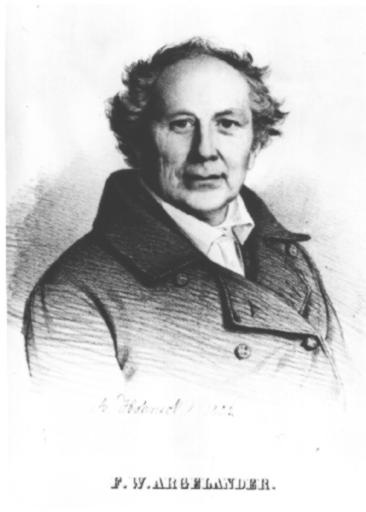<Back to Index>
- Astronomer Friedrich Wilhelm August Argelander, 1799
- Sculptor Thomas Gibson Crawford, 1814
- Holy Roman Emperor Maximilian I, 1459
PAGE SPONSOR
ΕΚΛΟΓΕΣ 2012
Τυπώστε και Ψηφίστε

Friedrich Wilhelm August Argelander (March 22, 1799 – February 17, 1875) was a German astronomer. He is known for his determinations of stellar brightnesses, positions, and distances.
Argelander was born in Memel in the Kingdom of Prussia (now Klaipėda in Lithuania), the son of a Finnish father and German mother. He studied with Friedrich Bessel, and obtained his Ph.D. in 1822 at Königsberg. From 1823 until 1837, Argelander was the head of the Finnish observatory at Turku then at Helsinki. He then moved to Bonn, Germany. There he developed a friendship with King Frederick William IV, who funded a new observatory at the University of Bonn.
Argelander excelled in developing effective, simple and fast methods for measuring star positions and magnitudes, thereby making a pioneering work for modern astronomy. He also measured star distances with heliometers. His, and his collaborators', great practical works of star cataloging and variable star research were made possible by the systematic usage of then newly developed techniques.
Argelander was the first astronomer to begin a careful study of variable stars. Only a handful were known when he began, and he was responsible for introducing the modern system of identifying them. He also made a rough determination of the direction in which the Sun was moving.
Together with Adalbert Krüger and Eduard Schönfeld, Argelander was responsible for the star catalogue known as the Bonner Durchmusterung, published between 1852 and 1859, which gave the positions and brightness of more than 324,000 stars, although it did not cover much of the southern half of the sky. This was the last star map to be published without the use of photography.
In 1863, Argelander founded an international organization of astronomers named the Astronomische Gesellschaft.
- The crater Argelander on the Moon and the asteroid 1551 Argelander are named for him.
- Argelander won the Gold Medal of the Royal Astronomical Society in 1863.
- He was elected a foreign member of the Royal Swedish Academy of Sciences in 1846.
- In 2006, the three astronomical institutes of the Bonn University were merged and renamed as the Argelander-Institut für Astronomie.